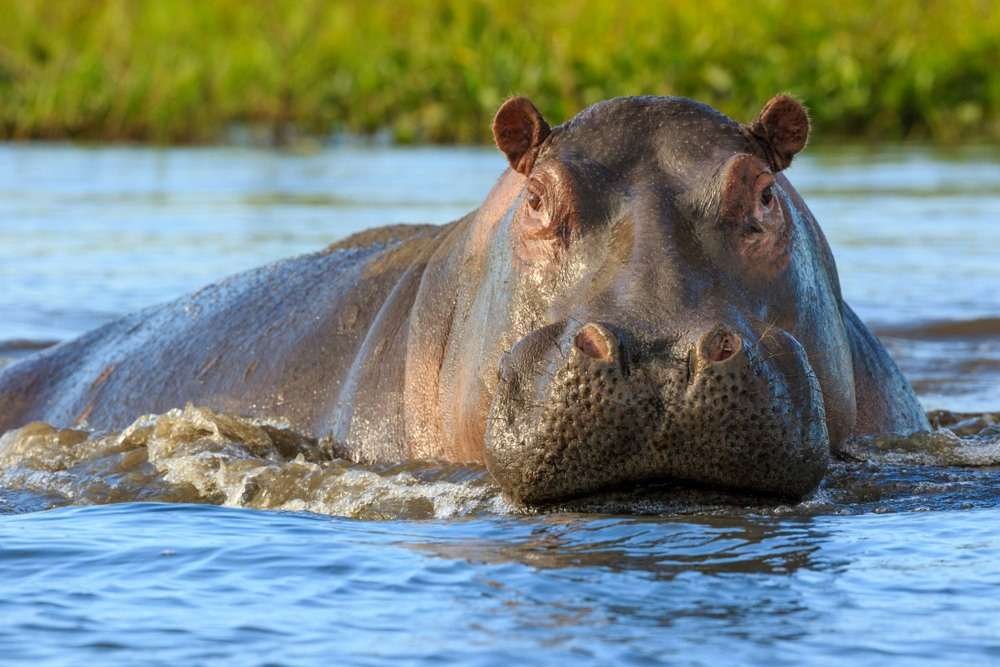Common Hippo
( mvuu, mfubu, kubu )
- Hippopotamus amphibius
- IUCN Status: Vulnerable
- Trend: decreasing

- Kingdom: Animalia
- Phylum: Chordata
- Class: Mammalia
- Order: Artiodactyla
- Family: Hippopotamidae
- Genus: Hippopotamus
Share:
General Information
Zambia is home of one of two types of Hippo, namely the Common Hippopotamus and it is the third largest land mammal in the world. The name ‘hippopotamus’ comes from the Ancient Greek for ‘river horse’. Some of the best places to see them in the wild would be in all the major rivers of the National Parks, especially in the Luangwa, Kafue and Zambezi Rivers. Hippopotamus are a key species – their foraging activities and behaviour has a profound effect on the aquatic ecosystem in which they live. They are more closely related to whales that to any other land mammal.
Fun Facts
The common Hippopotamus have the 5th strongest bite-force in the world at 1800 psi. They also produce their own sun-screen which an oily pinkish/red fluid that protects their skin against UV rays and acts as an antibiotic which helps protect them from infections.
Zambia has the largest concentration of hippos in the world. They are estimated to be between 20,000 and 40,000.
Description
Hippos are large, rotund, water loving animals. They have a large sturdy body, short stumpy legs, a large head, broad mouth that can open up to a metre wide, exposing their long curved canines. Their eyes, nostrils and ear are on the top of their head letting them see, hear and breathe whilst being almost submerged under water. Their thick greyish-brown skin is virtually hairless and moistened by a pink, oily secretion. They have four toes on each foot and are an even-toed mammal.- Shoulder height: 1.65 metres
- Length: 3.3 to 5 metres
- Weight: females 1,400 kg and males 1,600-3,200 kg
- Lifespan: 40-50 years
Ecology & Behaviour
Hippos have good eyesight and communicate by snorts, bellows and wheezes. 80% of communications are made under water, by subsonic vocalisations which can carry upriver. Males mark their territory by spreading their dung, vigorously wagging their tails, both in water and on land.
Hippos require sources of permanent water close to grasslands for grazing. They live in rivers, lakes and wetlands although they can survive in muddy wallows during very dry seasons.
They are fast for their size and can run up to 23 km per hour. If startled they run back to the water where they feel safe and they have been known to kill crocodiles who stray too close to their calves.
Conservation
Common hippopotamus are classified as Vulnerable on the IUCN Red List.
Distribution & Habitat
Hippos are very social and gregarious living in groups called ‘pods’. Pods consist of up to 30 females with their youngsters and are led by a dominant male. Males are territorial and fights over females can be very fierce.
They are semi-aquatic, spending up to 16 hours a day in water emerging at night to feed. They can stay under water, holding their breath for up to seven minutes. When they sleep in the water they automatically bob to the surface so that they can take a breath before sinking back down to the bottom. They graze on 35 kg of grass a night and will travel long distances from water to find food. They also eat fruit and are omnivores, having been observed to feed on carrion and birds. Females give birth to one baby after a gestation period of 230 days. Calves weigh up to 50 kg at birth and they suckle for up to 18 months, both on land and in the water. Youngsters are able to swim, closing their nose and eyes to block out water. They reach maturity at about five years old.
Interaction with Humans
Threats to the hippo populous include; poaching for their teeth for the illegal wildlife trade, loss of habitat and being omnivores they are susceptible to outbreaks of anthrax. The hippo is considered to be extremely aggressive and has frequently been reported charging and attacking boats. Small boats can easily be capsized by hippos and passengers can be injured or killed by the animals, or drown in the water. In one 2014 case in Niger, a boat was capsized by a hippo and 13 people were killed. Hippos will often raid farm crops if the opportunity arises, and humans may come into conflict with them on these occasions. These encounters can be fatal to either humans or hippos
No donation to this project yet.
| M | T | W | T | F | S | S |
|---|---|---|---|---|---|---|
| 1 | ||||||
| 2 | 3 | 4 | 5 | 6 | 7 | 8 |
| 9 | 10 | 11 | 12 | 13 | 14 | 15 |
| 16 | 17 | 18 | 19 | 20 | 21 | 22 |
| 23 | 24 | 25 | 26 | 27 | 28 | 29 |
| 30 | 31 | |||||


